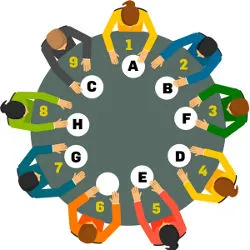Two teams, blue and red, play a game in which Red has a submarine we call October, as in Tom Clancy's novel The Hunt for Red October.
Dennis Shasha
Consider a configuration of six dancers on a grid, where three wear blue leotards and three wear red leotards.
Imagine a set of red and blue hill towns connected by a network of roads. When a person from a red town travels through a blue town or vice versa, things can get unpleasant.
You have three covered boxes of Burmese rubies before you. You know there are a total of 30 identical seven-carat rubies in the three boxes.
Consider 16 cards consisting of the ace through 8 of hearts and the ace through 8 of spades. You are allowed to arrange the cards as you wish. Your opponent chooses a number between 1 and 8.
In the spirit of Gomoku, two people play a version of the classic paper-and-pencil game tic-tac-toe but on an infinite checkerboard. In it, a player wins by getting four pieces in a row — vertically, horizontally, or diagonally.
In this cooperative game, two players want to meet each other in a graph as quickly as possible.
A group of people is sitting around your dinner table with one empty chair. Each person has a name that begins with a different letter: A, B, C . . . Because you love puzzles, you ask them to rearrange themselves . . .
Upstart Puzzles: Sleep No More
We begin simply, with a 60-minute clock that counts only minutes, from 0 to 59. The alarm can also be set from 0 to 59 and will go off when the clock reaches the same value.
Imagine a 500-square-by-500-square red/black ice checkerboard with walls along all four edges.
Shape the Future of Computing
ACM encourages its members to take a direct hand in shaping the future of the association. There are more ways than ever to get involved.
Get Involved








